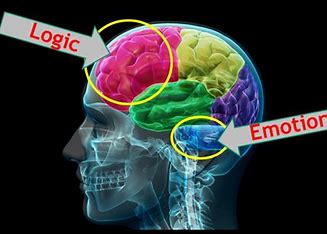15 Principles for Seeing Reality as It Is
Emotion is powerful. It propels us to stand up for justice, to love fiercely, to care deeply. And yet left unchecked, emotion—even righteous emotion—can lead us astray: fueling tribalism, distorting evidence, or hijacking our curiosity with biases.
Logic and curiosity, by contrast, offer a path toward clarity. They let us disentangle facts from feelings, question assumptions without personal baggage, and build conclusions that hold up under scrutiny. This tutorial lays out 15 principles—and practical tactics—for elevating logic and curiosity above raw emotion in your decision-making, conversations, and creative work.
1. Acknowledge Emotion—but Don’t Be Its Slave
>>> Why it matters: Emotions signal values (“This matters to me!”), but they aren’t proof.
>>> Practical step: Label your feeling—“I’m angry/frustrated/excited about X”—then ask: What evidence underlies this?
Tip: Keep a “feeling log” for a week. When strong emotions arise, pause and jot down the trigger + immediate thought. That practice builds awareness of emotional patterns.
2. Adopt the Beginner’s Mindset
>>> Why it matters: Preconceptions—often fueled by emotion—lock us into fixed views.
>>> Practical step: Before tackling any issue, jot down “What do I not know?” or “What if I’m completely wrong?”
Tip: Use questions beginning with “How might we…” or “What evidence would change my mind?” to prime curiosity.
3. Separate “Is” from “Ought”
>>> Why it matters: Feelings tell us how things ought to be; logic tells us how things are. Confusing them breeds denial.
>>> Practical step: When faced with a dilemma, write two columns: “Facts” vs. “Values.” Insist that “Facts” be verifiable.
Tip: Run each “Fact” through a reality-check: “How do I know this? What’s the source?”
4. Embrace Data, But Question Data Too
>>> Why it matters: Facts can be cherry-picked; data can be spun to fit narratives.
>>> Practical step: For any statistic or study, ask: Who funded it? What was the methodology? How big was the sample?
Tip: Seek at least two independent sources before accepting any data point.
5. Use the “Five Whys” to Drill Down
>>> Why it matters: Surface emotions often mask deeper root causes.
>>> Practical step: For every “why” you ask, answer with a “because,” then ask “why” again—up to five times—to reach root issues.
Tip: Keep “why” questions focused on systems and processes, not on blaming people.
6. Prioritise Arguments by Strength, Not by Loudness
>>> Why it matters: The most vociferous voices aren’t always the most rigorous.
>>> Practical step: In any debate or meeting, insist that each participant state their core argument and supporting evidence succinctly.
Tip: Use a timer to give each viewpoint equal airtime, then evaluate ideas based on evidence.
7. Build “Devil’s Advocate” Into Your Routine
>>> Why it matters: We all gravitate toward confirming our pre-existing beliefs.
>>> Practical step: Assign someone (or yourself) the role of intentionally arguing the opposite.
Tip: Rotate the role so the exercise stays honest—don’t let one person always shield cherished assumptions.
8. Anchor to First Principles
>>> Why it matters: Emotions latch onto secondary conflicts; first principles cut through to core truths.
>>> Practical step: Identify the foundational assumptions of any issue. Ask: “What laws of physics, economics, or human nature underpin this?”
Tip: Use Elon Musk’s approach: if you can’t break an issue down to “incontrovertible truths,” you’re building on sand.
9. Quantify When You Can—Qualify When You Can’t
>>> Why it matters: Numbers offer clarity; but some qualities evade neat measurement.
>>> Practical step: For every decision, ask: “Can I assign a metric? If not, what qualitative criteria matter?”
Tip: Create simple scoring rubrics (e.g., 1–5 for risk, 1–10 for impact) to compare options objectively.
10. Schedule “Reflection Windows”
>>> Why it matters: Under stress, emotion surges; logic fades.
>>> Practical step: Block out regular reflection periods (weekly, monthly) to review major decisions and their outcomes.
Tip: Ask: “Which choices were driven by gut? Did they pan out? What can I learn?”
11. Cultivate Intellectual Humility
>>> Why it matters: Overconfidence is emotion masquerading as certainty.
>>> Practical step: Whenever you state a strong belief, append a confidence level: “I believe X, with 70% confidence.”
Tip: Encourage colleagues to rate your confidence too, and discuss discrepancies.
12. Frame Disagreements as Shared Puzzles
>>> Why it matters: Emotions turn conflicts into “us vs. them.” Logic reframes them as joint problems to solve.
>>> Practical step: Replace “You’re wrong” with “Help me understand how X leads to Y.”
Tip: Document points of agreement first—emotion cools when you cement shared ground.
13. Use Trial Balloons and Micro-Experiments
>>> Why it matters: Big commitments fueled by emotion often backfire.
>>> Practical step: Before launching a major initiative, test a small prototype or survey a tiny sample.
Tip: Treat each micro-experiment as data: Define clear success metrics in advance.
14. Map Out Decision Trees
>>> Why it matters: Emotions prefer linear stories; reality unfolds in branching paths.
>>> Practical step: For complex choices, sketch a tree of possible actions, outcomes, and probabilities.
Tip: Update the tree with real results as you go—watch how your mental model evolves.
15. Reinforce the Cycle with Shared Accountability
>>> Why it matters: Logic thrives in cultures that reward honest feedback; emotion thrives in cultures that reward loyalty to ideas.
>>> Practical step: At project kick-offs, define who will hold whom accountable for evidence-based reviews.
Tip: Use transparent dashboards or public “post-mortems” to spotlight lessons learned, not just successes.
Putting It All Together
When you build habits around these 15 principles, logic and curiosity become your default lenses—transforming raw emotion from a steering wheel into a dashboard warning light. You remain sensitive to your values and passions (you wouldn’t want to lose your fire), but you no longer mistake intensity for insight. Instead, you cultivate a nimble, humble mindset that:
>>> Sees through tribal or echo-chamber biases
>>> Grabs hold of data—yet stays skeptical of easy answers
>>> Treats every disagreement as an opportunity to refine your map of reality
>>> Balances quantitative rigor with qualitative wisdom
>>> Learns fast by testing, reflecting, and iterating
Over time, this approach doesn’t just make your individual decisions stronger; it changes the culture of any group you’re in. Meetings become forums for joint inquiry rather than gladiatorial bouts. Teams embrace micro-experiments rather than grand gestures. And communities learn to elevate merit—rather than volume or sentiment—to decide which ideas truly matter.
In Summary
Emotion is neither good nor bad—it’s essential to our humanity. But intelligence demands that we manage emotion with tools of logic and curiosity. By systematically questioning our feelings, grounding our beliefs in evidence, and treating every doubt as a prompt to learn, we keep our compass pointed toward reality. That, in turn, frees us to channel our passion into solutions that actually work—rather than stumble onward, blinded by the force of our own convictions.
Next time you feel a surge—of anger, excitement, fear—pause. Check your log. Ask your “Five Whys.” Invite a devil’s advocate. Run a micro-experiment. Then return to the conversation, not as a zealot, but as a curious thinker. That shift won’t dampen your passion; it will make it more powerful, more precise, and infinitely more effective.






